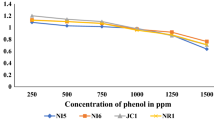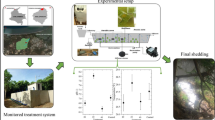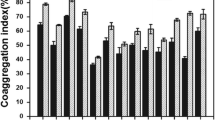Abstract
Singapore is an island city state with an economy dependent on petrochemicals and shipping, but with severely limited water resources. This study aimed to establish a suitable methodology specifically for the translation of a laboratory-scale system to an industrial scale for the treatment of phenol-contaminated wastewater. A habitat-specific microbial consortium was developed and reconstituted from 22 pure cultures dominated by Acinetobacter sp., Bacillus sp. and Pseudomonas sp. to form a synthetic biofilm-forming community with the capacity to degrade phenol-contaminated wastewater. The laboratory experiment was scaled-up to 400 m3 by using biotrickling reactors to reduce the phenol level from 407 mg L−1 to below detection limit over 104 days incubation. The results showed that the microbial consortia could also reduce the toxicity of the wastewater while degrading the phenol and lowering the wastewater COD. Further, this approach could be translated into the field without the need for a purpose-built primary treatment facility preventing the generation of excessive biomass and eliminating the need for sludge disposal.






Similar content being viewed by others
References
Adav, S. S., Chen, M.-Y., Lee, D.-J., & Ren, N.-Q. (2007). Degradation of phenol by Acinetobacter strain isolated from aerobic granules. Chemosphere, 67, 1566–1572.
Adetutu, E. M., Thorpe, K., Bourne, S., Cao, X., Shahsavari, E., Kirby, G., & Ball, A. S. (2011). Phylogenetic diversity of fungal communities in areas accessible and not accessible to tourists in Naracoorte Caves. Mycologia, 103, 959–968.
Afzal, M., Iqbal, S., Rauf, S., & Khalid, Z. M. (2007). Characteristics of phenol biodegradation in saline solutions by monocultures of Pseudomonas aeruginosa and Pseudomonas pseudomallei. Journal of Hazardous Materials, 149, 60–66.
Agency for Toxic Substances and Disease Registry (ATSDR) (2015). The priority list of hazardous substances that will be the candidates for toxicological profiles. http://www.atsdr.cdc.gov/spl/. Accessed Feb 2017
Alisi, C., Musella, R., Tasso, F., Ubaldi, C., Manzo, S., Cremisini, C., & Sprocati, A. R. (2009). Bioremediation of diesel oil in a co-contaminated soil by bioaugmentation with a microbial formula tailored with native strains selected for heavy metals resistance. The Science of the Total Environment, 407, 3024–3032.
Banerjee, A., & Ghoshal, A. K. (2010). Isolation and characterization of hyper phenol tolerant Bacillus sp. from oil refinery and exploration sites. Journal of Hazardous Materials, 176, 85–91.
Basak, B., Bhunia, B., Dutta, S., & Dey, A. (2013). Enhanced biodegradation of 4-chlorophenol by Candida tropicalis PHB5 via optimization of physicochemical parameters using Taguchi orthogonal array approach. International Biodeterioration & Biodegradation, 78, 17–23.
Bento, F. M., Camargo, F. A. O., Okeke, B. C., & Frankenberger, W. T. (2005). Comparative bioremediation of soils contaminated with diesel oil by natural attenuation, biostimulation and bioaugmentation. Bioresource Technology, 96, 1049–1055.
Bouchez, T., Patureau, D., Dabert, P., Juretschko, S., Dore, J., Delgenes, P., Moletta, R., & Wagner, M. (2000). Ecological study of a bioaugmentation failure. Environmental Microbiology, 2, 179–190.
Brenner, K., You, L., & Arnold, F. H. (2008). Engineering microbial consortia: a new frontier in synthetic biology. Trends in Biotechnology, 26, 483–489.
Burmølle, M., Webb, J. S., Rao, D., Hansen, L. H., Sørensen, S. J., & Kjelleberg, S. (2006). Enhanced biofilm formation and increased resistance to antimicrobial agents and bacterial invasion are caused by synergistic interactions in multispecies biofilms. Applied and Environmental Microbiology, 72, 3916–3923.
Chapman, P. M. (2000). Whole effluent toxicity testing—usefulness, level of protection, and risk assessment. Environmental Toxicology and Chemistry, 19, 3–13.
Chelliapan, S., & Sallis, P. J. (2011). Application of anaerobic biotechnology for pharmaceutical wastewater treatment. The 110AB Journal, Special Issue on Environmental Management for Sustainable Development, 2, 13–21.
Chemlal, R., Tassist, A., Drouiche, M., Lounici, H., Drouiche, N., & Mameri, N. (2012). Microbiological aspects study of bioremediation of diesel-contaminated soils by biopile technique. International Biodeterioration & Biodegradation, 75, 201–206.
Coulon, F., Al Awadi, M., Cowie, W., Mardlin, D., Pollard, S., Cunningham, C., Risdon, G., Arthur, P., Semple, K. T., & Paton, G. I. (2010). When is a soil remediated? Comparison of biopiled and windrowed soils contaminated with bunker-fuel in a full-scale trial. Environmental Pollution, 158, 3032–3040.
Diplock, E. E., Mardlin, D. P., Killham, K. S., & Paton, G. I. (2009). Predicting bioremediation of hydrocarbons: laboratory to field scale. Environmental Pollution, 157, 1831–1840.
Fang, F., Han, H., Zhao, Q., Xu, C., & Zhang, L. (2013). Bioaugmentation of biological contact oxidation reactor (BCOR) with phenol-degrading bacteria for coal gasification wastewater (CGW) treatment. Bioresource Technology, 150, 314–320.
Felföldi, T., Szekely, A. J., Goral, R., Barkacs, K., Scheirich, G., Andras, J., Racz, A., & Marialigeti, K. (2010). Polyphasic bacterial community analysis of an aerobic activated sludge removing phenols and thiocyanate from coke plant effluent. Bioresource Technology, 101, 3406–3414.
Gianfreda, L., Iamarino, G., Scelza, R., & Rao, M. A. (2006). Oxidative catalysts for the transformation of phenolic pollutants: a brief review. Biocatalysis and Biotransformation, 24, 177–187.
Goldstein, R., Mallory, L., & Alexander, M. (1985). Reasons for possible failure of inoculation to enhance biodegradation. Applied and Environmental Microbiology, 50, 977–983.
Gutierrez, M., Etxebarria, J., & De las Fuentes, L. (2002). Evaluation of wastewater toxicity: comparative study between Microtox® and activated sludge oxygen uptake inhibition. Water Research, 36, 919–924.
Head, I. M., Jones, D. M., & Röling, W. F. (2006). Marine microorganisms make a meal of oil. Nature Reviews Microbiology, 4, 173–182.
Homem, V., & Santos, L. (2011). Degradation and removal methods of antibiotics from aqueous matrices—a review. Journal of Environmental Management, 92, 2304–2347.
Hsien, T. Y., & Lin, Y. H. (2005). Biodegradation of phenolic wastewater in a fixed biofilm reactor. Biochemical Engineering Journal, 27, 95–103.
Iwamoto, T., & Nasu, M. (2001). Current bioremediation practice and perspective. Journal of Bioscience and Bioengineering, 92, 1–8.
Ji, J.-Y., Xing, Y.-J., Ma, Z.-T., Zhang, M., & Zheng, P. (2013). Acute toxicity of pharmaceutical wastewaters containing antibiotics to anaerobic digestion treatment. Chemosphere, 91, 1094–1098.
Jiang, Y., Wen, J., Bai, J., Jia, X., & Hu, Z. (2007). Biodegradation of phenol at high initial concentration by Alcaligenes faecalis. Journal of Hazardous Materials, 147, 672–676.
Jiang, L., Ruan, Q., Li, R., & Li, T. (2013). Biodegradation of phenol by using free and immobilized cells of Acinetobacter sp. BS8Y. Journal of Basic Microbiology, 53, 224–230.
Khan, M. I., Cheema, S. A., Tang, X., Hashmi, M. Z., Shen, C., Park, J., & Chen, Y. (2013). A battery of bioassays for the evaluation of phenanthrene biotoxicity in soil. Archives of Environmental Contamination and Toxicology, 65, 47–55.
Kuang, Y., Zhou, Y., Chen, Z., Megharaj, M., & Naidu, R. (2013). Impact of Fe and Ni/Fe nanoparticles on biodegradation of phenol by the strain Bacillus fusiformis (BFN) at various pH values. Bioresource Technology, 136, 588–594.
Łebkowska, M., Zborowska, E., Karwowska, E., Miaśkiewicz-Pęska, E., Muszyński, A., Tabernacka, A., Naumczyk, J., & Jęczalik, M. (2011). Bioremediation of soil polluted with fuels by sequential multiple injection of native microorganisms: field-scale processes in Poland. Ecological Engineering, 37, 1895–1900.
Lewis, K. (2010). Persister cells. Annual Review of Microbiology, 64, 357–372.
Li, M., Peng, L., Ji, Z., Xu, J., & Li, S. (2008). Establishment and characterization of dual‐species biofilms formed from a 3, 5‐dinitrobenzoic‐degrading strain and bacteria with high biofilm‐forming capabilities. FEMS Microbiology Letters, 278, 15–21.
Liu, J., Jia, X., Wen, J., & Zhou, Z. (2012). Substrate interactions and kinetics study of phenolic compounds biodegradation by Pseudomonas sp. cbp1-3. Biochemical Engineering Journal, 67, 156–166.
Lobo, C. C., Bertola, N. C., & Contreras, E. M. (2013). Stoichiometry and kinetic of the aerobic oxidation of phenolic compounds by activated sludge. Bioresource Technology, 136, 58–65.
Macaulay, B. M., & Rees, D. (2014). Bioremediation of oil spills: a review of challenges for research advancement. Annals of Environmental Science, 8, 2.
Macova, M., Escher, B., Reungoat, J., Carswell, S., Chue, K. L., Keller, J., & Mueller, J. (2010). Monitoring the biological activity of micropollutants during advanced wastewater treatment with ozonation and activated carbon filtration. Water Research, 44, 477–492.
McKenzie, N., Yue, S., Liu, X., Ramsay, B. A., & Ramsay, J. A. (2014). Biodegradation of naphthenic acids in oils sands process waters in an immobilized soil/sediment bioreactor. Chemosphere, 109, 164–172.
McKew, B. A., Coulon, F., Yakimov, M. M., Denaro, R., Genovese, M., Smith, C. J., Osborn, A. M., Timmis, K. N., & McGenity, T. J. (2007). Efficacy of intervention strategies for bioremediation of crude oil in marine systems and effects on indigenous hydrocarbonoclastic bacteria. Environmental Microbiology, 9, 1562–1571.
Mendonça, E., Picado, A., Paixao, S. M., Silva, L., Cunha, M. A., Leitao, S., Moura, I., Cortez, C., & Brito, F. (2009). Ecotoxicity tests in the environmental analysis of wastewater treatment plants: case study in Portugal. Journal of Hazardous Materials, 163, 665–670.
Mollaei, M., Abdollahpour, S., Atashgahi, S., Abbasi, H., Masoomi, F., Rad, I., Lotfi, A. S., Zahiri, H. S., Vali, H., & Noghabi, K. A. (2010). Enhanced phenol degradation by Pseudomonas sp. SA01: gaining insight into the novel single and hybrid immobilizations. Journal of Hazardous Materials, 175, 284–292.
Morikawa, M. (2006). Beneficial biofilm formation by industrial bacteria Bacillus subtilis and related species. Journal of Bioscience and Bioengineering, 101, 1–8.
Nuhoglu, A., & Yalcin, B. (2005). Modelling of phenol removal in a batch reactor. Process Biochemistry, 40, 1233–1239.
Park, M-R., Kim, D-J., Choi, J-W., Lim, D-S. (2013). Influence of immobilization of bacterial cells and TiO2 on phenol degradation. Water, Air, & Soil Pollution, 224(3), 1473.
Pitts, B., Hamilton, M. A., Zelver, N., & Stewart, P. S. (2003). A microtiter-plate screening method for biofilm disinfection and removal. Journal of Microbiological Methods, 54, 269–276.
Power, E. A., & Boumphrey, R. S. (2004). International trends in bioassay use for effluent management. Ecotoxicology, 13, 377–398.
Public Utilities Board of Singapore (2014). Requirements for discharge of trade effluent into the public sewers. Singapore: Sewerage and Drainage Act.
Reungoat, J., Escher, B., Macova, M., & Keller, J. (2011). Biofiltration of wastewater treatment plant effluent: effective removal of pharmaceuticals and personal care products and reduction of toxicity. Water Research, 45, 2751–2762.
Reungoat, J., Escher, B., Macova, M., Argaud, F., Gernjak, W., & Keller, J. (2012). Ozonation and biological activated carbon filtration of wastewater treatment plant effluents. Water Research, 46, 863–872.
Rigo, M., & Alegre, RM. (2004). Isolation and selection of phenol-degrading microorganisms from industrial wastewaters and kinetics of the biodegradation. Folia Microbiologica, 49, 41–45.
Rodríguez-Martínez, E. M., Pérez, E. X., Schadt, C. W., Zhou, J., & Massol-Deyá, A. A. (2006). Microbial diversity and bioremediation of a hydrocarbon-contaminated aquifer (Vega Baja, Puerto Rico). International Journal of Environmental Research and Public Health, 3, 292–300.
Saravanan, P., Pakshirajan, K., Saha, P. (2008). Growth kinetics of an indigenous mixed microbial consortium during phenol degradation in a batch reactor. Bioresource Technology, 99, 205–209.
Shong, J., Diaz, M. R. J., & Collins, C. H. (2012). Towards synthetic microbial consortia for bioprocessing. Current Opinion in Biotechnology, 23, 798–802.
Song, H., Liu, Y., Xu, W., Zeng, G., Aibibu, N., Xu, L., & Chen, B. (2009). Simultaneous Cr(VI) reduction and phenol degradation in pure cultures of Pseudomonas aeruginosa CCTCC AB91095. Bioresource Technology, 100, 5079–5084.
Stephenson, D., & Stephenson, T. (1992). Bioaugmentation for enhancing biological wastewater treatment. Biotechnology Advances, 10, 549–559.
Tekin, H., Bilkay, O., Ataberk, S. S., Balta, T. H., Ceribasi, I. H., Sanin, F. D., Dilek, F. B., & Yetis, U. (2006). Use of Fenton oxidation to improve the biodegradability of a pharmaceutical wastewater. Journal of Hazardous Materials, 136, 258–265.
Thompson, I. P., van der Gast, C. J., Ciric, L., & Singer, A. C. (2005). Bioaugmentation for bioremediation: the challenge of strain selection. Environmental Microbiology, 7, 909–915.
USEPA. (1990). Test methods for evaluating solid waste: laboratory manual for physical and chemical methods (SW 486). Washington, DC: USEPA.
Van Der Gast, C. J., Whiteley, A. S., & Thompson, I. P. (2004). Temporal dynamics and degradation activity of an bacterial inoculum for treating waste metal-working fluid. Environmental Microbiology, 6, 254–263.
Vijayagopal, V., & Viruthagiri, T. (2005). Kinetics of biodegradation of phenol using mixed culture isolated from mangrove soil. Pollution Research, 24(1), 157.
Wagner-Dobler, I. (2003). Microbial inoculants: snake oil or panacea. In Bioremediation: a critical review (pp. 259–289). Norfolk: Horizon Scientific Press.
Yoshida, S., Ogawa, N., Fujii, T., & Tsushima, S. (2009). Enhanced biofilm formation and 3-chlorobenzoate degrading activity by the bacterial consortium of Burkholderia sp. NK8 and Pseudomonas aeruginosa PAO1. Journal of Applied Microbiology, 106, 790–800.
Zhao, D., Liu, C., Liu, L., Zhang, Y., Liu, Q., & Wu, W.-M. (2011). Selection of functional consortium for crude oil-contaminated soil remediation. International Biodeterioration & Biodegradation, 65, 1244–1248.
Author information
Authors and Affiliations
Corresponding author
Rights and permissions
About this article
Cite this article
Poi, G., Aburto-Medina, A., Mok, P.C. et al. Bioremediation of Phenol-Contaminated Industrial Wastewater Using a Bacterial Consortium—from Laboratory to Field. Water Air Soil Pollut 228, 89 (2017). https://doi.org/10.1007/s11270-017-3273-0
Received:
Accepted:
Published:
DOI: https://doi.org/10.1007/s11270-017-3273-0




